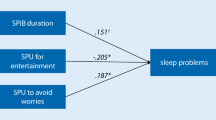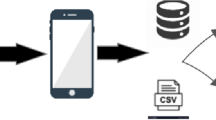Abstract
Purpose
Smartphones are prevalently used among adolescents; however, nighttime exposure to blue-enriched light, through electric devices, is known to induce delays of the circadian rhythm phases and poor morning somatic conditions. We therefore investigated whether evening smartphone use may affect sleep-wake cycle and cardiac autonomic nervous system (ANS) activity after awaking in dormitory students.
Methods
The participants were high school students, living under dormitory rules regarding the curfew, study, meals, lights-out, and wake-up times. The students were forbidden from the use of both television and personal computer in their private rooms, and only the use of a smartphone was permitted. According to prior assessment of smartphone use, we chose age-, sex-, exercise time-matched long (n = 22, >120 min) and short (n = 14, ≤60 min) groups and compared sleep-wake cycle and physiological parameters, such as cardiac ANS activity, blood pressure, and intra-aural temperature. All measurements were performed during 6:30 to 7:00 a.m. in the dormitories.
Results
Compared with the short group, the long group showed a significantly lower cardiac ANS activity (2727 ± 308 vs. 4455 ± 667 ms2, p = 0.030) with a tendency toward a high heart rate, in addition to later bedtimes during weekdays and more delayed wake-up times over the weekend. Blood pressure and intra-aural temperature did not differ between the groups.
Conclusions
In this population, evening smartphone use may be associated with altered sleep-wake cycle and a diminished cardiac ANS activity after awakening could be affecting daytime activities.
Similar content being viewed by others
References
Perkinson-Gloor N, Lemola S, Grob A (2013) Sleep duration, positive attitude toward life, and academic achievement: the role of daytime tiredness, behavioral persistence, and school start times. J Adolesc 36:311–318
Institute for Information and Communications Policy (2014a) 2013 Survey on information behavior regarding information and communications technologies. [in Japanese] http://www.soumu.go.jp/iicp/chousakenkyu/data/research/survey/telecom/2014/h25mediariyou_3report.pdf. Accessed 5 Jan 2017
Institute for Information and Communications Policy (2014b) Survey on addiction/influence of the internet and smartphone app use targeting high school students. [in Japanese] http://www.soumu.go.jp/main_content/000302914.pdf. Accessed 5 Jan 2017
Carskadon MA (2011) Sleep in adolescents: the perfect storm. Pediatr Clin N Am 58:637–647
Cajochen C, Frey S, Anders D, Späti J, Bues M, Pross A, Mager R, Wirz-Justice A, Stefani O (2011) Evening exposure to a light-emitting diodes (LED)-backlit computer screen affects circadian physiology and cognitive performance. J Appl Physiol 110:1432–1438
Brainard GC, Hanifin JP, Greeson JM, Byrne B, Glickman G, Gerner E, Rollag MD (2001) Action spectrum for melatonin regulation in humans: evidence for a novel circadian photoreceptor. J Neurosci 21:6405–6412
Khalsa SB, Jewett ME, Cajochen C, Czeisler CA (2003) A phase response curve to single bright light pulses in human subjects. J Physiol 549:945–952
Kalsbeek A, Scheer FA, Perreau-Lenz S, La Fleur SE, Yi CX, Fliers E, Buijs RM (2011) Circadian disruption and SCN control of energy metabolism. FEBS Lett 585:1412–1426
Matsumoto T, Miyawaki C, Ue H, Kanada T, Yoshitake Y, Moritani T (2001) Comparison of thermogenic response to food intake between obese and non-obese young women. Obes Res 9:78–85
Task Force of the European Society of Cardiology and the North American Society of Pacing and Electrophysiology (1996) Heart rate variability standards of measurements, physiological interpretation, and clinical use. Circulation 93:1043–1065
Motokubota N, Komai N, Suzuki M, Hayashi I, Moritani T, Nagai N (2015) Influence of evening preference on daytime variation of autonomic nervous system activity, gastric motility, and appetite sensations in young women. J Jpn Soc Nutr Food Sci 69:65–74 [in Japanese]
Yamaguchi M, Watanabe T, Takagi A, Wakisaka S, Sakane N, Moritani T, Nagai N (2011) Morningness-eveningness preference and the autonomic nervous system activity in the morning among female university students. J Jpn Soc Psychosom Obstet Gynecol 16:160–168 [in Japanese]
Nagai N, Matsumoto T, Kita H, Moritani T (2003) Autonomic nervous system activity and the state and development of obesity in Japanese school children. Obes Res 11:25–32
Nagai N, Moritani T (2004) Effect of physical activity on autonomic nervous system function in lean and obese children. Int J Obes Relat Metab Disord 28:27–33
Nagai N, Hamada T, Kimura T, Moritani T (2004) Moderate physical exercise increases cardiac autonomic nervous system activity in children with low heart rate variability. Childs Nerv Syst 20:209–214
Munezawa T, Kaneita Y, Osaki Y, Kanda H, Minowa M, Suzuki K, Higuchi S, Mori J, Yamamoto R, Ohida T (2011) The association between use of mobile phones after lights out and sleep disturbances among Japanese adolescents: a nationwide cross-sectional survey. Sleep 34:1013–1020
Carskadon MA, Vieira C, Acebo C (1993) Association between puberty and delayed phase preference. Sleep 16:258–262
Takagi A, Taniguchi A, Komai N, Mura E, Nagai H, Moritani T et al (2014) Evaluation of postprandial core or peripheral temperatures after oral stimulation with carbonated water using a modified sham-feeding test. J Jpn Soc Nutr Food Sci 67:19–25 [in Japanese]
Abhishekh HA, Nisarga P, Kisan R, Meghana A, Chandran S, Raju T, Sathyaprabha TN (2013) Influence of age and gender on autonomic regulation of heart. J Clin Monit Comput 27:259–264
Faulkner MS, Quinn L, Rimmer JH, Rich BH (2005) Cardiovascular endurance and heart rate variability in adolescents with type 1 or type 2 diabetes. Biol Res Nurs 7:16–29
Koenig J, Kemp AH, Beauchaine TP, Thayer JF, Kaess M (2016) Depression and resting state heart rate variability in children and adolescents—A systematic review and meta-analysis. Clin Psychol Rev 46:136–150
Parisotto V, Lima EM, Silva JM, de Sousa MR, Ribeiro AL (2008) Cardiac sympathetic dysautonomia in children with chronic kidney disease. J Nucl Cardiol 15:246–254
Rodríguez-Colón SM, He F, Bixler EO, Fernandez-Mendoza J, Vgontzas AN, Calhoun S, Zheng ZJ, Liao D (2015) Metabolic syndrome burden in apparently healthy adolescents is adversely associated with cardiac autonomic modulation—Penn State Children Cohort. Metabolism 64:626–632
Buchheit M, Platat C, Oujaa M, Simon C (2007) Habitual physical activity, physical fitness and heart rate variability in preadolescents. Int J Sports Med 28:204–210
Farah BQ, Barros MV, Balagopal B, Ritti-Dias RM (2014) Heart rate variability and cardiovascular risk factors in adolescent boys. J Pediatr 165:945–950
Kreier F, Yilmaz A, Kalsbeek A, Romijn JA, Sauerwein HP, Fliers E, Buijs RM (2003) Hypothesis: shifting the equilibrium from activity to food leads to autonomic unbalance and the metabolic syndrome. Diabetes 52:2652–2656
Czeisler CA, Klerman EB (1999) Circadian and sleep-dependent regulation of hormone release in humans. Recent Prog Horm Res 54:97–130
Leproult R, Copinschi G, Buxton O, Van Cauter E (1997) Sleep loss results in an elevation of cortisol levels the next evening. Sleep 20:865–870
Cajochen C (2007) Alerting effects of light. Sleep Med Rev 11:453–464
Chang AM, Aeschbach D, Duffy JF, Czeisler CA (2015) Evening use of light-emitting eReaders negatively affects sleep, circadian timing, and next-morning alertness. Proc Natl Acad Sci U S A 112:1232–1237
van der Lely S, Frey S, Garbazza C, Wirz-Justice A, Jenni OG, Steiner R, Wolf S, Cajochen C, Bromundt V, Schmidt C (2015) Blue blocker glasses as a countermeasure for alerting effects of evening light-emitting diode screen exposure in male teenagers. J Adolesc Health 56:113–119
Oh JH, Yoo H, Park HK, Do YR (2015) Analysis of circadian properties and healthy levels of blue light from smartphones at night. Sci Rep 5:11325
Acknowledgments
We are grateful to all participants, their parents, high school teachers, and housemothers and fathers of the dormitories for their cooperation. We also wish to express our appreciation to Dr. Kaneyoshi Ishihara, in Notre Dame Seishin University, who gave us the permission to use the Japanese version of MEQ. This work was supported by JSPS KAKENHI Grant Numbers 24500988 and 15H02901.
Author information
Authors and Affiliations
Corresponding author
Ethics declarations
Conflicts of interest
The authors declare that they have no conflicts of interest.
Rights and permissions
About this article
Cite this article
Nose, Y., Fujinaga, R., Suzuki, M. et al. Association of evening smartphone use with cardiac autonomic nervous activity after awakening in adolescents living in high school dormitories. Childs Nerv Syst 33, 653–658 (2017). https://doi.org/10.1007/s00381-017-3388-z
Received:
Accepted:
Published:
Issue Date:
DOI: https://doi.org/10.1007/s00381-017-3388-z




